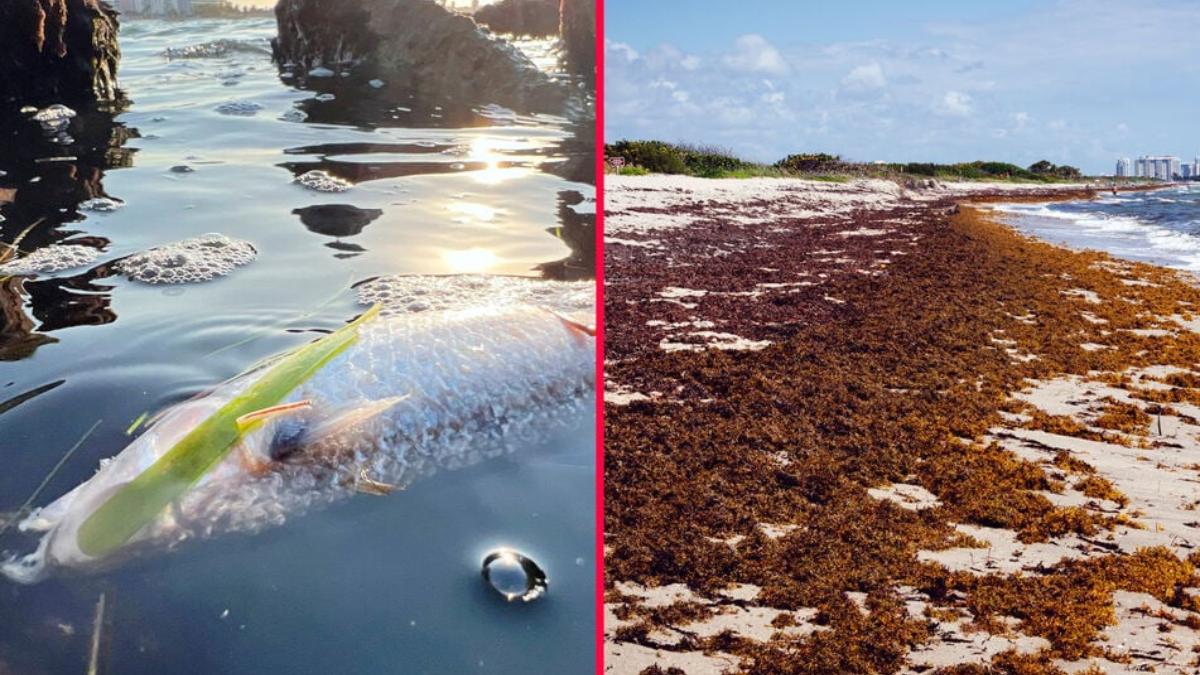Environmental groups and local residents are raising alarms about the growing toxic red tide bloom off the coast of Florida, urging Governor Ron DeSantis to take immediate action by declaring a state of emergency. The persistent bloom of harmful algae, which has been plaguing the Gulf Coast, is wreaking havoc on marine life, public health, and local economies. As the situation worsens, environmentalists are demanding that state officials step up efforts to combat the red tide and mitigate its damaging effects.
What Is Red Tide and Why Is It Dangerous?
Red tide refers to a naturally occurring bloom of algae, specifically Karenia brevis, that produces toxic compounds harmful to both marine life and humans. These blooms can last for weeks or even months, depending on environmental conditions such as water temperature and nutrient levels. The toxins released by red tide can cause massive fish kills, harm marine mammals and birds, and negatively affect the quality of air and water.
In addition to its ecological impact, red tide poses significant risks to public health. People exposed to red tide toxins through inhalation or contact with contaminated water may experience respiratory issues, eye irritation, and skin rashes. For individuals with pre-existing respiratory conditions, such as asthma, exposure to red tide toxins can exacerbate symptoms and cause serious health problems. The economic consequences are also substantial, with tourism, fishing, and local businesses often taking a significant hit during red tide events.
Current Red Tide Situation in Florida
The ongoing red tide bloom has affected vast stretches of Florida’s Gulf Coast, particularly in areas such as Sarasota, Manatee, and Lee counties. Reports of dead fish washing up on beaches, the deterioration of water quality, and the decline of marine life have become increasingly common. The toxic bloom has also been causing respiratory issues for residents and visitors in the region. While red tide blooms are not uncommon in Florida, the current bloom is larger and more persistent than usual, prompting widespread concern among environmental advocates and local communities.
Environmentalists argue that the state’s failure to declare a state of emergency and provide adequate resources to address the red tide crisis is exacerbating the situation. They point to the severe environmental and economic toll the bloom has taken, as well as the long-term impacts it may have on Florida’s marine ecosystem.
Why Do Environmentalists Want a State of Emergency?
Environmental groups, including the Florida Wildlife Federation and the Sierra Club, are calling on Governor DeSantis to declare a state of emergency to mobilize resources for both immediate and long-term response efforts. A state of emergency would allow for greater coordination between state and federal agencies, facilitate the allocation of funds for cleanup efforts, and provide support for affected communities.
One of the primary reasons for the call to declare an emergency is the ongoing damage to Florida’s marine life. The toxic algae has killed millions of fish, including key species such as redfish, snook, and grouper. In addition to the fish kills, there have been reports of dolphins, manatees, and sea turtles being affected by the toxins. The devastating effects on wildlife have raised alarms among conservationists who fear that the long-term impacts of the bloom could damage Florida’s biodiversity.
In addition to its ecological consequences, the red tide bloom has disrupted Florida’s lucrative tourism and fishing industries. The state’s pristine beaches, once a major draw for tourists, have become tainted by the unpleasant sight and smell of decaying fish, while local businesses have reported losses due to reduced visitor numbers. Fishermen are also facing major setbacks as the bloom has rendered many fishing areas unsafe or unproductive, further straining the local economy.
Governor DeSantis’ Response to the Red Tide
Governor Ron DeSantis has faced criticism for not taking swift action to address the red tide bloom, with many arguing that his response has been inadequate given the scale of the crisis. While the DeSantis administration has directed the Florida Fish and Wildlife Conservation Commission (FWC) and the Department of Environmental Protection (DEP) to monitor the situation, critics believe more aggressive measures are necessary to curb the bloom’s effects.
Some actions have been taken to address the crisis, including the deployment of resources to remove dead fish from beaches, monitoring air quality, and supporting local health departments in their response to respiratory issues. However, environmental groups argue that these efforts are insufficient and do not address the root causes of red tide, such as nutrient pollution, which is believed to contribute to the severity of the blooms. They urge the governor to take a more comprehensive approach, including working to reduce nutrient pollution and implementing long-term strategies to prevent future blooms.
Addressing the Root Causes of Red Tide
Environmentalists are also calling for greater focus on addressing the environmental factors that contribute to the occurrence of red tide. Nutrient pollution from agricultural runoff, wastewater discharge, and stormwater runoff has been identified as a key factor in exacerbating the intensity and duration of red tide blooms. Excess nutrients, particularly nitrogen and phosphorus, can fuel the growth of algae, including Karenia brevis, the organism responsible for red tide.
In response to this, environmental groups are advocating for stronger regulations on agricultural and industrial practices that contribute to nutrient pollution. They also stress the importance of investing in water treatment technologies that can reduce nutrient levels in runoff before it enters Florida’s waterways.
Conclusion: A Call to Action
The ongoing red tide bloom in Florida is a clear example of the environmental and economic consequences of unchecked pollution and climate change. As the bloom continues to devastate marine life, harm public health, and disrupt local economies, the call for action grows louder.
Environmentalists are urging Governor DeSantis to declare a state of emergency to provide the resources necessary to address the immediate crisis, while also pushing for long-term solutions to prevent future red tide events.
For more information on the impact of red tide in Florida, visit Florida Fish and Wildlife Conservation Commission.
Disclaimer – Our team has carefully fact-checked this article to make sure it’s accurate and free from any misinformation. We’re dedicated to keeping our content honest and reliable for our readers.








